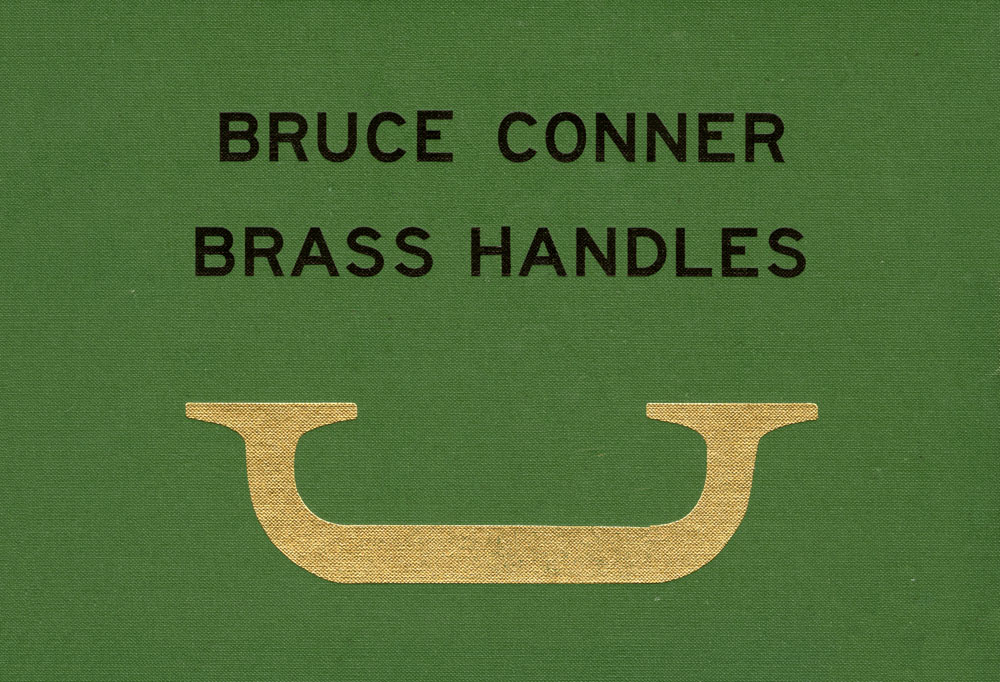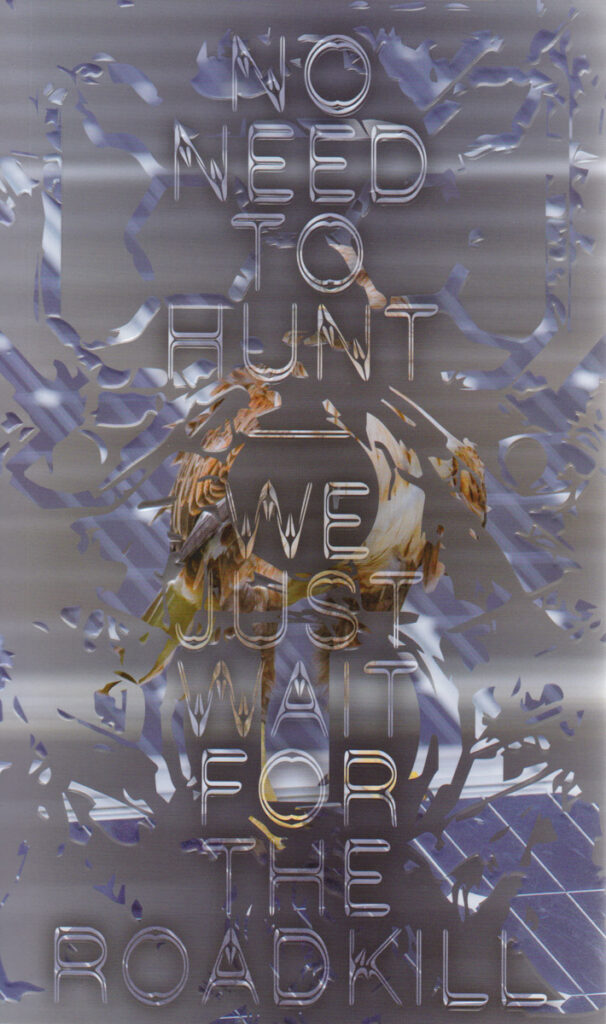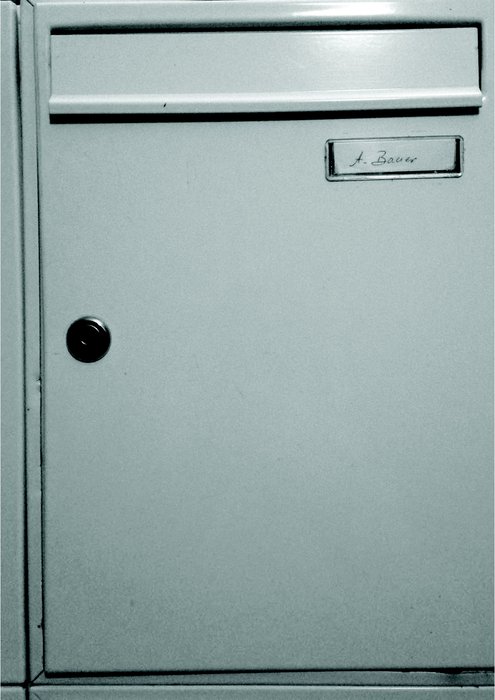Michiel Huijben, Monika Janulevičiūtė, Martins Kohout and Bianca Pedrina in conversation with Will Pollard
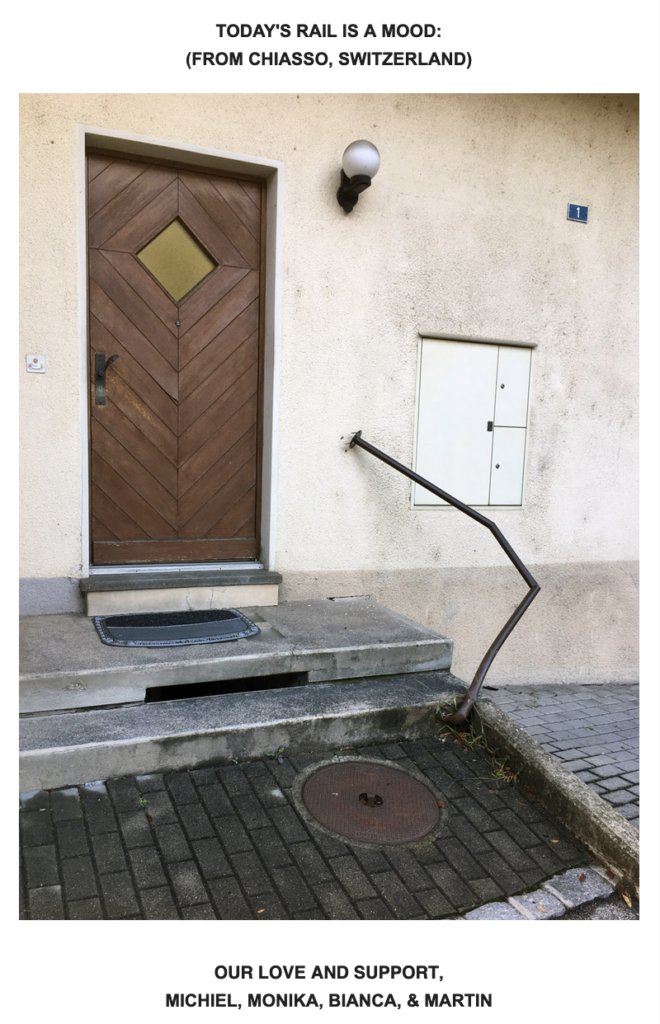
Every Wednesday, an almost-shadowy, pseudo-anonymous collective known as the Handrail Awareness Group issues the latest edition of their newsletter, bringing (typically) a solitary image of a handrail to the inboxes of their subscribers. What started as something of a private joke — a fascination shared between friends as they traipsed the streets of Rotterdam, Berlin, Vienna and Vilnius — has now gathered the attention of an enthusiastic international readership who submit their own contributions to the group’s growing archive. New images of urban support structures both public and private have been sent in from as far afield as Kyoto, Barcelona, Milan, Hong Kong and Zierikzee. Themselves currently distributed between Lithuania, Germany, Austria and the Netherlands, the founding members of HAG spoke to San Serriffe about the curiosity motivating this project, and what the newsletter, as a form of publishing, can offer.
Will Pollard: Hi, HAG! How did you come to do this together?
Martins Kohout: I’ll speak first about me and Michiel, but I think we almost immediately extended the project to become this group of four. So, in a certain way, I would say, the discussion between me and Michiel was more like a trigger, and then the shaping of the project was definitely shared among the four of us.
It came from the two of us almost just joking about how we both take pictures of handrails — or that we have even done works with handrails. Like, I did actual sculptures that were, you could say, “functional” handrails more than ten years ago. And then we knew that Bianca was actually capturing a lot of — more than just handrails — these, like, moments in architecture or public space, and we both thought that it would be also great to work with Monika. It was also because, at the time, I already knew — and I think Michiel, too — that Monika was working on this project about benches, because there was an essay that was earlier than the Bench book, so we thought there was also some sort of shared sensitivity or interest. What do the others think about this origin story?
Michiel Huijben: Actually, at the very beginning, it was just sharing pictures of handrails on WhatsApp — Martins and I — and then Bianca also started sending us these things. And then that evolved into an idea of seeing what ways there could be to publish this growing collection, and that’s when Monika first got involved, right?
Monika Janulevičiūtė: I think so! I didn’t know the prehistory of it, and it was very unclear for me — was this something that had been on-going for, like, four years. . . or two years. . . or twenty-four hours?
MK: I forgot we had this WhatsApp group. At one moment, Michiel was in Berlin, and we were like, “Let’s just go around my neighbourhood and look for — like, hunt for — handrails.” So we started taking these pictures. One of them — I think we even shared it somewhere online — it’s just Michiel on a handrail, sliding down. And then I think we were joking that we would make a calendar or something about it. Like, we were still discussing what shape. . . so the fact that it’s a newsletter came collectively, later.
MH: I guess we were already working on a publication — so, some sort of book or a zine or something. But it turned out to be kind of impossible because the collection just kept growing, you know? So we could never settle on some sort of finished form for a publication, because, yeah, people were sending us things by this point, and the collection just became bigger and bigger. It felt really stupid to make a book when you already knew you’d have to make another book three weeks after it came back from the printer or something. I mean, we had enough material for multiple books to begin with. And that’s when the idea for a mailout came up.
WP: That must have also meant that when you started a weekly newsletter, you already knew that you had enough material for. . . X many years?
MH: Yeah, that’s true! And also, like, every week we send each other pictures, but other people also keep sending them to us. . . so in theory this newsletter will never end.
MK: I think we would manage a daily newsletter as well, if we wanted to.
WP: Do you get much feedback from your readers? Do people get in touch to say, like, “Thank you for bringing this handrail into my life?”
Bianca Pedrina: Oh, we do get fan mails, actually. I think Michiel’s more into the inbox — I rarely look at it — but when I go through the messages, it’s like, “You made my day. . . It was an amazing handrail today!” And you think, “Wow!” So, maybe it makes a difference? It makes people’s lives better?
MH: One thing I’ve heard quite often, actually, is that — people say — it gives a nice rhythm to their week? In terms of their inbox. Because there’s a lot of spam — I guess you could call this spam as well, although it’s not spam, because people actually register for it — and spam is irregular. But this. . . there’s kind of a very strict rhythm to this. People have said that they appreciate that. Like, “Oh yeah, it’s Wednesday.”
WP: Of the images of handrails that have been sent out to the newsletter so far, do you personally have favourites? Or perhaps certain newsletters that seem like landmark editions?
BP: I think it’s interesting that we built this collection of images very early on, and we didn’t know what to do with it at first, or, like, we had something in print in mind. But then, you know, there’s these mother images — like a kombucha mother — and you keep seeing them. And it’s interesting that now I don’t know the authorship anymore of the images. I’ve forgotten if I took it or one of the others took it? So it’s kind of built like a universe.
MK: We launched the newsletter with a small pop-up exhibition in Vienna where we had to select a group of them, and I feel like they’re really, in my head at least, the flagship images, because we really had to go through multiple rounds, selecting which of them to print. Even though we were covering the whole front of the exhibition space, we could not put all of our favourites there. We still had to choose. Monika might remember the number better. . . maybe a dozen images? So, we really had to go through them over and over and over to make this pre-selection.
I also just wanted to mention that, earlier we said we always have this panic on Wednesday, but sometimes we plan the images in advance, or, like, we had a guest for a month who was then selecting them. Sometimes we come up with an idea that connects them throughout the month — which sometimes is announced, sometimes not announced. Like, when Monika’s bench book was published, for that month we were always sending a pair of handrail and bench from it. And I think in the past a few times we also tried to, like, have a key in it that we do not make so clear — and maybe it’s not so important if people find it out, but for us it helps, I think, to navigate through how to select out of so many images. Because they’re really, really nice and we have just so many of them.
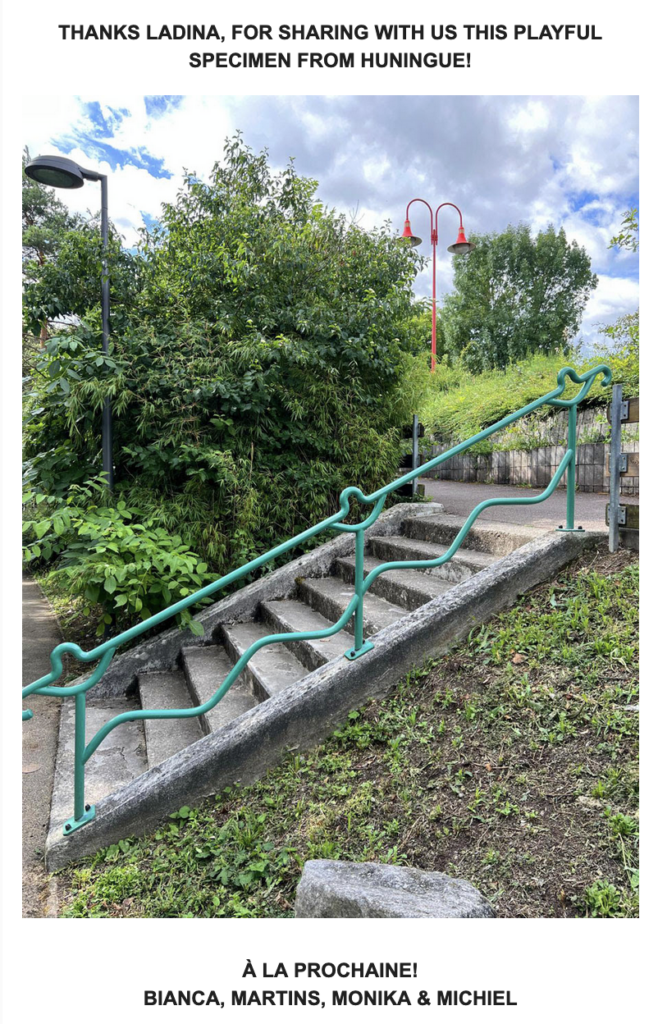
WP: I was curious what the importance is for you of highlighting handrails in particular — because there are other sorts of everyday architectural elements that you could have chosen. I think you refer somewhere to the handrail as a “support structure,” and to my mind it’s also an accessibility aid, so it has this particular connotation to it: it’s there to help. What’s the importance to you of giving “awareness” to that, even if the term is used half-jokingly?
MJ: I feel like it’s a historical tool, a parameter on how people see and organise their cities. In Vilnius, for example, there’s roughly three types of outdoor handrail, and I was telling Martins two weeks ago, when he was visiting Vilnius. I have passed some handrails hundreds of times, and I never took photos of them, usually they just look like any other handrail in Lithuania. And then when I see the handrail photographs from Switzerland or the Netherlands — especially the interior ones, where the handrail is part of the Gesamtkunstwerk — it’s uncanny and surprising how much attention is given to detail.
BP: Maybe it’s also interesting to add that there was this idea, in the pandemic, that handrails were kind of political, and had this societal role that was changing.
MH: Exactly, when you were supposed to be keeping away from each other.
MJ: Not touching!
MK: In the past we’ve also discussed what the definition of “handrail” is. In English, for example, it really tells you: it’s the thing that guides your hand or that your hand grips. It’s not a fence, it’s not a barrier that protects you from tripping over a ridge or something, but it’s literally where there is this interaction between your hand and some aim or some intention.
When I was making these very soft, almost “fetish” handrails — I was always fascinated by the fact that there’s also two directions to look at. Like, who is in the position of power and who has control? Does the handrail have power over you because it forces you to walk up the stairs near the wall — not up the middle, where you can’t reach it when you need its help — or do you have the power? Because you’re used to it being that when you grab something, you feel like, “It’s in my hand, I’m the powerful one.” It’s this really intimate and at the same time almost always shared interaction.
I’m now in Athens for a month, and I really like the different handrails, because usually when you walk down the street, the entrances to most houses, at least in the neighbourhoods I’ve been going to, are made of glass, and so you see into the first part of the hallway, which often has stairs right behind it. And the handrails are very beautiful because they’re part of the architectural design of the house.
At the same time, I also find it nice to see handrails that have been added, which are many of the handrails in the pictures we send — these kind of “addition” handrails or “hacked” handrails — or “forgotten” handrails, because sometimes the original structure has kind of changed and so the handrail no longer makes sense. You always have a history of or an attempt at something being fixed, and I think it’s really nice.
MH: On the one hand, you can read certain rules and regulations of a country from its handrails, and of course in certain types of homes or architectures the handrail is a part that is “designed” along with everything else, like Monika was also saying. But wherever it’s not, it’s still needed, you know? I really like that that’s when people start adding things — so the handrail is also a signifier of people’s needs and also their inventiveness and kind of how important design and function is to them.
You know, there could be one handrail that is just fine for the whole world. There’s only one shape really needed: it’s a tubular shape that is attached to a wall. But actually, when you go and look, there is an incredible variety of these things — material variety, formal variety, colour, whatever — and that’s what I think is really amazing about it.
BP: Well, that’s always interesting, right? How people reclaim their power in public space — like Martins was saying. Handrails guide you but people in the city also decide where they actually need to go. It’s like those desire paths that evolve naturally, by people walking on them.
MK: That reminds me of the differences in different countries. I remember once I sent this picture into the group which was literally a grey wall, a super clean wall with no detail on it, a very super elementary stainless-steel handrail, and then like three squares of different colours as a decoration on the wall. And immediately Bianca was like, “Oh, you’re in Switzerland!” And I was like, “This is so crazy.” You can tell, you know? It was really like the most basic — the shape of the handrail itself was a super basic steel tube — yet in a way, it was so clear. It speaks a lot about what was outside of the picture frame. Like, not that you could find this moment and situation only in Switzerland, but it was just this incredible thing — just, like, putting these three coloured squares there, as an attempt to beautify the place, having the wall perfectly grey, and then this steel, kind of shiny and perfect — it was just playing into this stereotype, as well. And I thought it was quite amazing that sometimes, in a way, you need very little and you can clearly put it into some kind of context.
And also, with the power that we were discussing — I think that often what I find interesting is that when you have, let’s say, a public stair or, in the subway you often have these kinds of handrails that are in the middle of the passage, so they’re kind of splitting the space into two different directions, right? And it creates always this idea of, okay, that’s usually not a handrail that you really grip onto, but you could — on the stairs, you would — but you know that if you were walking on the wrong side you would really get into trouble very quickly. And I always found this quite fascinating: that it’s really almost like a fixed barrier, even though at the same time it’s not just a barrier, it’s also helping you — and it’s just a tube, as was said. It’s just like a pipe in space, but it does so much.
WP: I guess knowing that the newsletter exists might change the way you relate to any new city spaces you visit — if some part of your brain is always thinking, “Keep an eye out, there might be a good handrail.”
BP: There are many subscribers who’ve told us, like, “Hey, I can’t unsee handrails now.” Even my father. He’s addicted to the newsletter, by the way.
MK: And my partner has started taking pictures of me taking pictures of handrails. . .
MH: So has mine.
BP: We should do a newsletter on Thursdays that’s just us taking our pictures.
MK: But then we would reveal our identities!
MH: I think they’ve been revealed?
MJ: Not so much. I was introduced to some friends of friends in Vilnius, and then one of them was looking at me for a bit, hesitating, and then saying, “From the handrail thing maybe?” And everyone was like, “What?” And I was nodding, “Yes!” And they were all like, “What. . . What do you know that we don’t know?” And I was like, “No, no, it’s about this newsletter,” and they were like, “What?!” and this guy was also like, “What. . . You don’t know?”
MH: We at first really liked the anonymity. I don’t know if we’ve always put our names underneath?
MK: Yes, we always did, but I think we also forgot very quickly that we did not put our full names anywhere on the website, and also not in the email. Only later someone reminded us that actually it’s anonymous and we were like, “Oh, maybe that’s cool?” But we never realised, because in the opening show we were just calling ourselves the Handrail Awareness Group.
BP: The opening was nice, actually. We just made this poster on the wall and there was nothing in the space — except a bar, naturally!
MH: And a sign-up form.
BP: Yeah, a sign-up form. And then we —Martins, Michiel and I — were in Vienna and we pressed the button together for the first time to send the newsletter.
MH: Will, it was like a concept store in the Nine Streets. It looked like that.
MK: And then we had a walk, a guided tour.
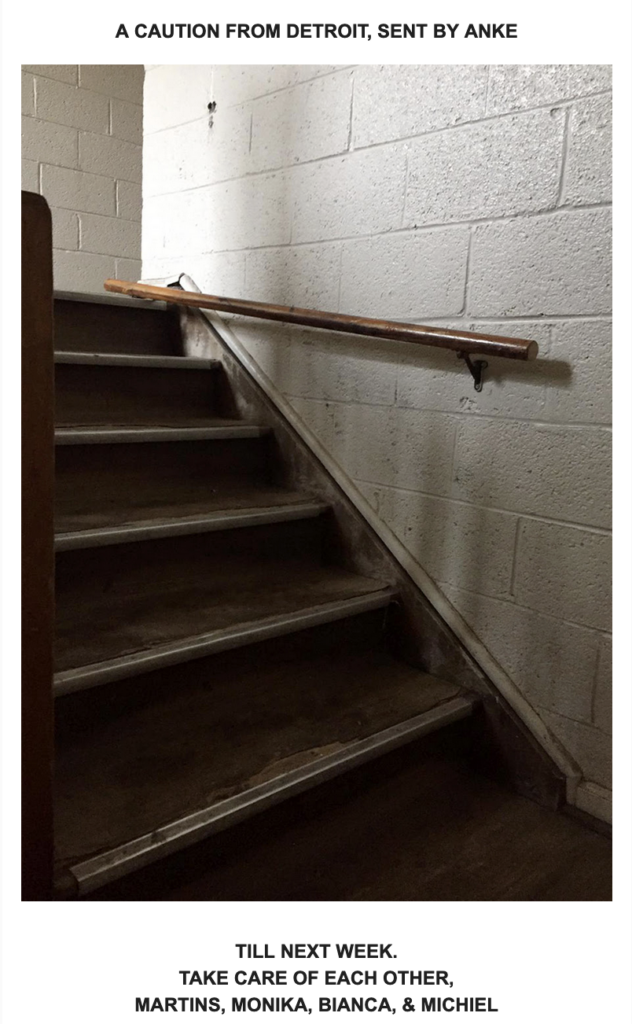
WP: Beyond the content of the newsletter, I wanted to know how you’re thinking about the newsletter itself as a form or platform. But before we get to that: before you started making the HAG newsletter, were you newsletter subscribers yourselves? Were you signed up to any other newsletters?
MK: There are a few newsletters that I definitely like and can recommend. Like, the Hopscotch Reading Room in Berlin has, for example, a really beautiful newsletter. I recently have been reading one called Love Letters, and there are quite a few, but then it often becomes this thing of, like, you open it but you keep it on the side, because it’s text, and maybe it comes in a moment when you’ve not necessarily decided to make the time for it. So, I also think our newsletter is very easy in the sense that you just look at a picture.
WP: Yeah, it doesn’t ask anything of me, which is appreciated when my inbox is otherwise a fraught place. It’s often a source of stress, or it’s where I go to do bureaucracy. So it was quite a specific decision, that the images should appear there, in people’s inboxes, instead of, for example, on an Instagram account?
MH: Yeah, there’s a deliberate choice not to make an Instagram account. Recently we found out that a friend of mine has actually claimed the name @HandrailAwarenessGroup, the handle, on Instagram. I guess he’s hoping that one day we’ll find some money and buy him out or something — he’s like an early dot-com entrepreneur. But I really like that it’s not an Instagram account that just has to keep being added to. . . I like that it’s a periodical, you know? It appears and then it disappears again, and then next week it will appear again. And, okay, you can find the archive, but in essence the newsletter just shows up in your inbox, and then — actually, I would be curious how you all do it. Do you delete it afterwards, or do you keep your newsletters? Generally, do you think people keep these?
MK: Michiel, do you want us to delete our own newsletter?
MH: No! But I mean, who’s going to keep the back catalogue, except for us, you know? In a way it could be like, “Ah, I’ve seen it, it’s Wednesday, cool,” and then you delete it again. And I like that idea, that’s it’s just something that, as you said, doesn’t ask anything of you. It just appears and then it disappears again — if you delete it, I guess.
BP: Let’s ask Will — what are you doing with them?
WP: I don’t delete anything. It’s a problem I have. But it also means: I can go back and search through them.
BP: That was also part of the idea, no? That each individual subscriber has their own archive.
MH: And it’s directed at you, you know? You know, an Instagram page, you can go to it or not, and if we were to post something it might pop up in your feed, but as a part of a stream, or something, whereas this is sent to you. I like that, in any case, about the newsletter.
MK: It’s a bit like an encounter. Because if you start subscribing this week, you will never see the previous ones. That’s kind of also a difference. Even when we did the calendar, we used pictures that were not in the newsletter.
MH: Plus, you know, there’s not so many metrics involved as there is with Instagram — where it suddenly becomes about numbers of likes or interactions or whatever. This is just like, you know, you send it out and that’s it. It’s not like Instagram, where it feeds into this kind of dopamine shot.
WP: I don’t want to ask “What’s next?” as if to imply that something should change, because one of the things I like about the project is that it’s such a simple idea. But you have already experimented with, as you say, having guest curators.
MJ: I think we are down to play with that format in the upcoming months. It’s quite funny — it helps with setting a narrative, which is funny to have. The same joke repeats.
MH: I don’t know how, but I do think this idea of a narrative that would play out over a given period would be a nice thing to play with. We’ve also played with the idea of “Reports from . . . Warsaw” or something, you know? And then you just have someone who’s there, just for a month or however long, only sending things from there.
BP: Or from a specific building or institution — a very closed-up environment?
WP: A question particularly for you Michiel and Martins, given you are both busy with publishing projects outside of the newsletter, with Flat i and TLTRPreß: How does this more ephemeral newsletter project relate to how you’re thinking about publishing more generally, or publishing in other forms?
MH: For me, what’s really nice is that the newsletter is a form of publishing that has a very different speed, and reacts much more to impulses. Making books is a very long and durational and costly affair, and I really like the speed of this and the fact that it’s us deliberating over multiple locations and just agreeing on something and throwing it out. There’s not so much fear about getting something wrong, because it’s just, like, on to the next one, or something.
MK: I think I can put it in the context of TLTRPreß. In the history of TLTR there were a lot of these more ephemeral or digital or non-physical outputs. There was, like, another email publication, and for a long time I wanted to do a fax publication, but of course most people don’t have fax anymore. For me, personally, TLTR never — as the name suggests, it came about as a joke, and then it became serious — I was never really aiming to do print as the main thing, it’s just that for a lot of projects it is the most fitting or the best form, or it’s the form that everybody involved feels is the perfect one for the project.
As Monika, who has been really involved in many of them, can also say, everyone involved in those projects would discuss it together — and it’s the same here, we were really discussing, like, “What’s the best format?” And we still use the name, right? We talk as if we are an art collective or a collective of enthusiasts — there is this social element to it, and this idea that the group could also grow. Maybe it will one day be larger than this? We were always also thinking about what would happen if we pretended that this has been existing for longer, that it has its own history and its own quirks and we just play along with it?
So I think in that sense, with the publishing, I was really happy to do a project in the form of a newsletter, and I also like that it’s not just a TLTRPreß project. It’s co-published with Michiel, and at the same time it has this group dynamic. So, somehow it’s not really important who is publishing it?
BP: Yeah, I think it’s very nice that it’s a collective decision every Wednesday. Of course a book is a collective decision as well, but then everybody has a role, usually. There’s so much money involved and it’s also very slow. So that’s why we opted for the newsletter in the end — it’s not a time-capsule, it’s ongoing, and it doesn’t even have a back catalogue if you’re not logging it yourself. So it’s this very — yeah, it’s something ephemeral, in a way. I really like this freedom. It opens up new ideas.
MJ: Yeah, as much as I like designing books, I was also happy not to design this one! Not because it would be a hassle, but it’s just quite liberating to research and actually execute things — make them alive — in more sustainable or less intensive kinds of ways. I think not everything needs to be an artist book.

